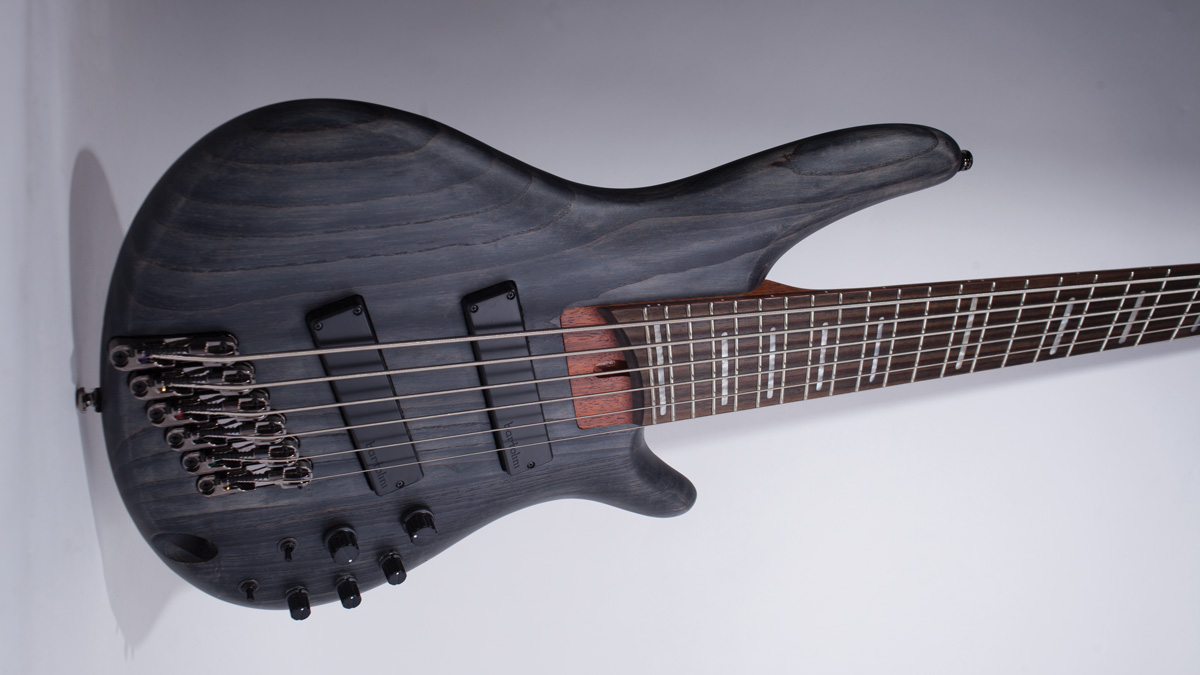MusicRadar Verdict
If a six-string is on your shopping list, or if you fancy a dabble in the murky world of extended range basses, look no further.
Pros
- +
Well constructed with good balance, a wide array of tones and great playability.
Cons
- -
None.
MusicRadar's got your back
With Dingwall basses ploughing the fanned fret furrow with some success, it was only a matter of time before other manufacturers became aware of the playing benefits.
Being a six-string monster, this bass should particularly benefit from the playing comfort that fanned fretting affords. Let's take a look!
Build Quality
We don't think we've ever played an Ibanez bass that wasn't comfortable to wear, with a high degree of playability, and this bass continues that trend. It balances very well for a six-string and the familiar SR styling works despite very little rear contouring.
The slim body depth and rounded horns make up for this while the slim neck profile works fine with the broad rosewood fingerboard and 16.5mm string spacing for comfortable left-hand fretting.
The open grain body timber and fingerboard colouring give the bass an organic, woody vibe that straddles the more modern elements of this design rather well. Mother of pearl block markers adorn the 24-fret fingerboard with white dot markers on the side.
The set-up and overall level of finishing is excellent, apart from a slight rough patch on the satin finished jatoba and bubinga multi-laminate neck at the headstock join: otherwise the frets are well dressed, with no sharp fret ends in evidence, giving the neck a sleek feel - helpful when navigating a broad six-string neck. The neck joint is also tight and stable with no visible gaps around the neck pocket.
The Ibanez tuners, finished in Cosmo Black, operate smoothly, as do the five controls (volume, pickup pan, bass, middle and treble, the treble control also acting as a passive tone control).
The two switches offer mid- EQ switching (250 Hz, 450 Hz and 700 Hz respectively) and EQ bypassing. A pair of Bartolini BH1 pickups have been matched with the Ibanez three- band EQ circuit: the pickups have been positioned in a slanted fashion to coincide with the fanned fret system and the changes in scale length with respect to each string. The Mono-rail V bridge uses individual units for each string and like the tuners, are finished in Cosmo Black.
Sounds and Playability
As with most SR basses, this instrument has a bright, natural acoustic tone that resonates strongly, each string sounding full and responsive across the whole neck.
The timbers give this bass a solid delivery with a strong and vibrant fundamental tone: plugging in, this bass immediately shows what it's all about. The dual-coil pickups provide a strong note-for-note delivery - even with the EQ set flat, and with the tonal possibilities that a six-string bass affords, this is pleasing to hear.
Panning across both pickups, the usual characteristics are evident: full- bodied, rounded tones from the neck pickup, increased brightness and twang from the bridge pickup. Taking the low B and high C strings into consideration, we're pleased to report that this bass performs exceptionally well for a sub-£800 Indonesian-made instrument. Ibanez should be commended: this puts some £2,000+ instruments to shame.
The EQ and switching options give the player all the tone-shaping facilities they require, but with the extended high and low ranges, and the added frequency response that the extra neck and body timber naturally provide, investigating the EQ and experimenting with different settings for different playing styles is advisable.
Too much bass boost can swamp your tone, while too much treble can make your sound brittle and ineffective, particularly when using the C string. Yet again, getting to know the mid-EQ settings, the available frequencies and how they work in relation to fingerstyle, pick playing, slapping and tapping, is a worthwhile exercise if you want to get the most out of this bass.
Fanned frets make most sense when used on a six-string, we feel, to offer the player improved comfort. Six-string basses are notoriously a handful: no matter how light or comfortable they are, there's no getting away from the dimensions and bulkiness of a six-string neck. The fanned frets offer some relief to the fretting hand and in use, this bass with its sleek SR neck provided one of the most comfortable six- string bass playing experiences we've encountered.
Ibanez has made good use of the fanned fretting on this bass, and no doubt on the five-string model too. At this price, you are getting a very good six-string instrument with all the Ibanez hallmarks, a plethora of tonal options, comfort, playability and an impressive sonic display.

“Almost a lifetime ago, a few Burnage lads got together and created something special. Something that time can’t out date”: Original Oasis drummer Tony McCarroll pens a wistful message out to his old bandmates

“A high-quality solution for capturing your drums”: Sennheiser MD 421 Kompakt review

“I need to build a sound of my own that has the power that I want”: Floating Points hates festival sound systems so much that he’s invented his own









